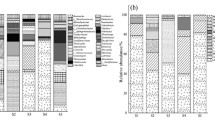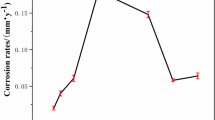Abstract
Microbiologically influenced corrosion (MIC) is a kind of electrochemical corrosion that is enhanced by the effect of certain microorganisms including sessile bacteria. In this investigation, more than 200 samples collected from different systems of Iranian refineries have been examined (by culturing methods and observations) for corrosion-enhancing, biofilm-producing microorganisms such as sulfate-reducing bacteria (SRB), iron-oxidizing bacteria (IOB), heterotrophic biofilm-forming bacteria (HBB), and some eukaryotes such as fungi. This study showed the presence of microorganisms, such as SRB, HBB, thermophillic HBB, and yeasts, except for IOB. It was also revealed that biocides are used to reduce the number of planktonic (floating) bacteria, instead of the number of sessile bacteria, that form biofilms. Using surfactants, or washing with chemicals like chlorine or organic acids in overhauls, may destroy the biofilm and free the residential bacteria into the bulk solution, thus exposing them to the biocide. For thick biofilms, a chlorine or acid wash may also yield the same results.
Similar content being viewed by others
References
H.-C. Flemming, Economical and Technical Overview, Microbially Influenced Corrosion of Materials, E. Heitz, H.-C. Flemming, and W. Sand, Ed., Springer-Verlag, Berlin, 1996
R. Javaherdashti and R.K. Singh Raman, “Microbiologically Influenced Corrosion of Stainless Steels in Marine Environments: A Materials Engineering Approach,” presented at Engineering Materials 2001, The Institute of Materials Engineering, Melbourne, Australia, September 2001
R. Cord-Ruwisch, MIC in Hydrocarbon Transportation Systems, Corrosion Australasia, 1996, 21 (1), p 8–12
M. Pakshir and H. Azad, “The Role of Sulfate-Reducing Bacteria on Buried Gas Pipelines Under Cathodic Protection,” presented at 4th National Corrosion Congress (Isfahan, Iran), Isfahan University of Technology, April–May 1996, in Persian
H. Ghassem and N. Adibi, Bacterial Corrosion of Reformer Heater Tubes, Mater. Perf., 1995, 34 (3)
N. Amoozegar et al., “Problems Caused by Not Controlling Microorganisms in Circulating Cooling Water Systems in Oil, Gas and Petrochemical Industry,” presented at 8th Congress of Oil, Gas and Petrochemical Industry, Tehran, Iran, 1998, in Persian
M. Setareh and R. Javaherdashti, Assessment and Control of MIC in a Sugar Cane Factory, Mater. Corrosion, 2003, 54 (4), p 259–263
B.J. Little and P. Wagner, Myths Related to Microbiologically Influenced Corrosion, Mater. Perf., 1997, 36 (6), p 40–44
Cooling Water Treatment Manual, 3rd ed., TPC1 Publication, NACE International Publications, Houston, TX
“A Working Party Report on Microbiological Degradation of Materials and Methods of Protection,” European Federation of Corrosion Publication No. 9, The Institute of Materials, U.K., 1992
G.G. Geessey, Biofilm Formation, A Practical Manual on Microbiologically-Influenced Corrosion, G. Kobrin, Ed., NACE International Publications, Houston, TX, 1993
H.W. Rossmoore, Ed., Handbook of Biocide and Preservative Use, Blackie Academic & Professional (Chapman and Hall), Glasgow, U.K., 1995, sections 3.2 to 3.5
D.G. Enos and S.R. Taylor, Influence of Sulfate-Reducing Bacteria on Alloy 625 and Austenitic Stainless Steel Weldments, Corrosion, 1996, 52 (11)
S.C. Dexter and J.P. LaFontain, Effect of Natural Marine Biofilms on Galvanic Corrosion, Corrosion, 1998, 54 (11)
K. Xu, S.C. Dexter, and G.W. Luther, Voltammetric Microelectrodes for Biocorrosion Studies, Corrosion, 1998, 54 (10)
S.C. Dexter, Biological Effect, Metals Handbook, 9th ed., Vol 13, Corrosion, ASM International, 1987, p 41–43
S.C. Dexter, Localized Biological Corrosion, Metals Handbook, 9th ed., Vol 13, Corrosion, ASM International, 1987, p 114–120
M.L. Bauccio, Corrosion in the Aircraft Industry, Metals Handbook, 9th ed., Vol 13, Corrosion, ASM International, 1987, p 1031–1032
W.H. Dickinson, Z. Lewandowski, and R.D. Geer, Evidence for Surface Changes During Ennoblement of Type 316L Stainless Steel: Dissolved Oxidant and Capacitance Measurements, Corrosion, 1996, 52 (12)
B.J. Little, P. Wagner, K. Hart, R. Ray, D. Lavoie, K. Nealson, C. Aguilar, “The Role of Metal Reducing Bacteria in Microbiologically Influenced Corrosion,” Paper 215, Corrosion/97, Houston, TX: NACE (National Assoc. of Corrosion Engineers), 1997
D.H. Pope and E.A. Morris III, Some Experiences with Microbiologically-Influenced Corrosion, Mater. Perf., 1995, 34 (5)
S.W. Borenstein and P.B. Lindsay, “MIC Failure Analyses,” Paper 381, presented at CORROSION/87 (Houston, TX) NACE (National Assoc. of Corrosion Engineers), 1987
I.T. Staley, M.P. Bryant, N. Pfenning, and J.G. Holt, Bergey’s Manual of Systematic Bacteriology, Vol 3, Williams & Wilkins, 1989, section 22
American Petroleum Institute, “Biological Analysis of Water-Flood Injection Waters,” Report API RP-38, American Petroleum Institute, 1975, out of print
P.J.B. Scott and M. Davis, Monitoring Bacteria in Waters: The Consequences of Incompetence, Mater. Perf., 1999, 38 (6)
R. Javaherdashti, A Review of Some Characteristics of MIC Caused by Sulphate-Reducing Bacteria: Past, Present and Future, Anti-Corrosion Methods Mater., 1999, 46 (3)
J.F.D. Stott, B.S. Skerry, and R.A. King, “Laboratory Evaluation of Materials for Resistance to Anaerobic Corrosion Caused by Sulphate Reducing Bacteria: Philosophy and Practical Design,” The Use of Synthetic Environments for Corrosion Testing, STP 970, P.E. Francis and T.S. Lee, Ed., ASTM, 1988, p 98–111
P.J.B. Scott and J. Goldie, Ranking Alloys for Susceptibility to MIC: A Preliminary Report on High-Mo Alloys, Mater. Perf., 1991, 30 (1)
R.W. Schutz, A Case for Titanium’s Resistance to Microbiologically Influenced Corrosion, Mater. Perf., 1991, 30 (1)
P. Wagner and B.J. Little, Impact of Alloying on Microbiologically Influenced Corrosion: A Review, Mater. Perf., 1993, 32 (9)
W.A. Hamilton, Sulphate-Reducing Bacteria and Anaerobic Corrosion, Ann. Rev. Microbiol., 1985, 39, p 195–217
J.A. Hardy and J.L. Bown, The Corrosion of Mild Steel by Biogenic Sulfide Films Exposed to Air, Corrosion, 1984, 40 (12)
W. Lee and W.G. Characklis, Corrosion of Mild Steel under Anaerobic Biofilm, Corrosion, 1993, 49 (3)
J.F.D. Stott, Assessment and Control of Microbially Induced Corrosion, Met. Mater., 1988, April, p 224–229
S.Y. Li, Y.G. Kim, K.S. Jeon, Y.T. Kho, T. Kang, Microbiologically Influenced Corrosion of Carbon Steel Exposed to Anaerobic Soil, Corrosion, 2001, 57 (9), p 815–824
R.C. Newman, K. Rumash, and B.J. Webster, The Effect of Pre-Corrosion on the Corrosion Rate of Steel in Natural Solutions Containing Sulphide: Relevance to Microbially Influenced Corrosion, Corrosion Sci., 1992, 33 (12)
A.K. Tiller, Is Stainless Steel Susceptible to Microbial Corrosion?, Proceedings of the Conference Sponsored and Organized Jointly by The National Physics Laboratory and The Metals Society, The Metals Society, London, 1983, p 104–107
A. Neville and T. Hodgkiess, Comparative Study of Stainless Steel and Related Alloy Corrosion in Natural Sea Water, Br. Corrosion J., 1998, 33 (2), p 111–119
“Standard Test Method for Iron Bacteria in Water and Water-formed Deposits”, D932-85 (Reapproved 1997), Annual Book of ASTM Standards, ASTM, 1997
H.A. Videla, Manual of Biocorrosion, CRC Press, Inc., 1996, p 74–120
S.W. Borenstein, Microbiologically Influenced Corrosion Failures of Austenitic Stainless Steel Welds, Mater. Perf., 1988, 27 (8)
www.corrosion-doctors.org/Microbial/Bacteria.htm, May 2001
J.G. Stoecker, Guide for the Investigation of Microbiologically Influenced Corrosion, Mater. Perf., 1981, 20 (8)
J. Starosvetsky, R. Armon, A. Groysman, D. Starosvetsky, Fouling of Carbon Steel Heat Exchanger Caused by Iron Bacteria, Mater. Perf., 1999, 38 (1), p 55–60
D.W. Brinley III and A.A. Moccari, MIC Causes Weld Problems, Mater. Perf., 2000, 38 (6)
M.P. Silverman and D.G. Lundgren, Studies on the Chemoautothrophic Iron Bacterium, J. Bacteriol., 1959, 77, p 642–647
Author information
Authors and Affiliations
Rights and permissions
About this article
Cite this article
Setareh, M., Javaherdashti, R. Evaluation of sessile microorganisms in pipelines and cooling towers of some Iranian industries. J. of Materi Eng and Perform 15, 5–8 (2006). https://doi.org/10.1361/10599490523896
Received:
Revised:
Issue Date:
DOI: https://doi.org/10.1361/10599490523896




